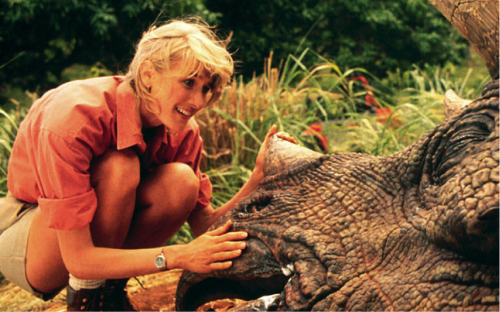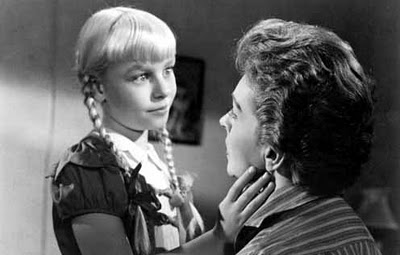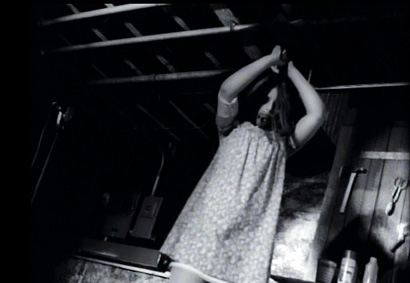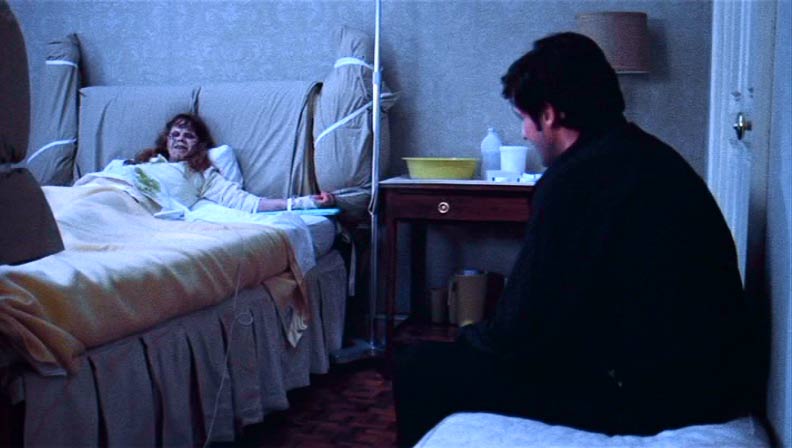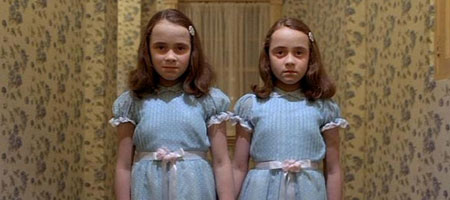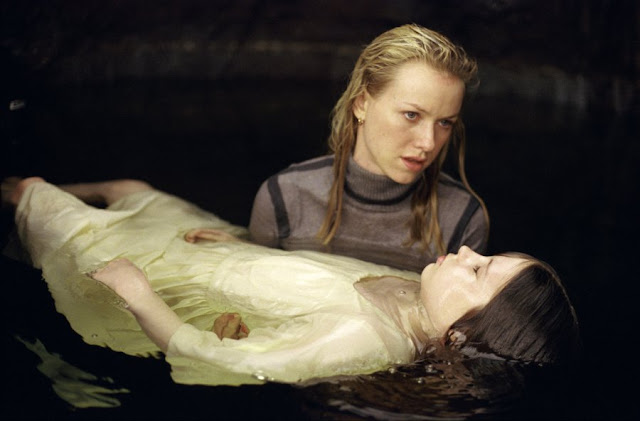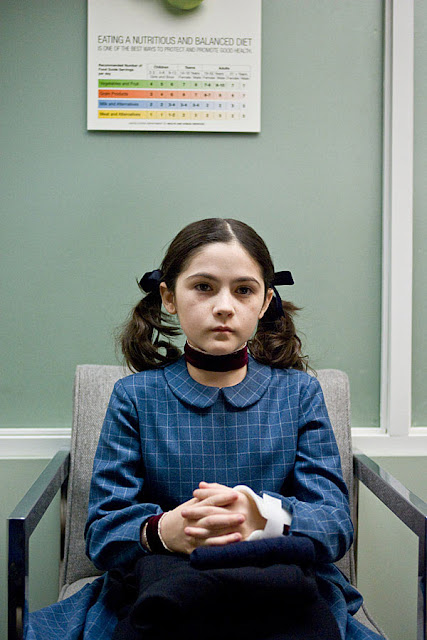This is a guest post by Ashley Barry.
Jurassic World‘s opening cinematic had me starry eyed and shivering with excitement. The familiar but epic score accompanied by grand, sweeping shots of Costa Rica transported me right back to my childhood. I’m surprised my face didn’t fracture because a smile was perpetually plastered on it during the entire length of the introductory cinematic. I was home and temporarily lost in the labyrinth of my own nostalgia.
The first installment of the series was released in 1993 and, for some unknown reason, my parents allowed me to watch it. I was five years old and an easily spooked kid (I was afraid of shower drains for crying out loud). With the exception of the infamous tyrannosaurus rex scene, during which I hid underneath a heavy blanket I couldn’t see through, I was blown away by the idea of a dinosaur park and I idolized Ellie Sattler. The franchise itself later evolved into a familial tradition, my dad toting home the newest installment from the rental store whenever I came down with some form of the plague.
It’s difficult to outdo the original movie and, at times, Jurassic World seemed like it was trying to do just that. Though Jurassic World was filled with throwbacks, even going so far as to revisit the original park, I preferred the first film because it didn’t focus so much on gender politics. They were in a crisis situation and there was no time to argue or zone in on such things. Anybody could be a dinosaur’s dinner. Jurassic Park was the first of its kind and, for me at least, the character development was more organic and believable.
Ellie, an empowering character, was never required to forgo her femininity or empathy to be strong and capable. Though she adhered to the final girl trope during the scene in which she had to override the controls in the control room (the most inconveniently placed control room ever), she was an expert in her field and, whether she was working in the dirt or reaching into a colossal pile of triceratops dung, she was unafraid to literally dirty her hands. Though she was just as capable as her male counterparts and coworkers, she still rocked her neatly pinned hair and cut off shorts.
Ellie was never criticized for having a career or not being maternal enough, as if there’s some kind of scale in existence that makes such a determination. She was able to retain her femininity and empathy whereas Claire, in Jurassic World, switched from a hardened non-maternal figure to a maternal figure, a transition that felt forced. I truly believe Claire was assigned a negative and unforgiving reputation. Whether it was the digs at her femininity or her disinterest in having children of her own, it was an unfair reputation she didn’t deserve.
Claire Dearing, the parks operations manager, is a great example of a modern if not progressive woman in that she’s highly career-oriented and ambitious. I reveled in the fact that she’s a female identifying person who’s in a position of power in the corporate world, which is a typically male-dominated space. It’s great to see her acting as her own agent, but in selecting a career over a family, Claire is often distracted and, at times, disconnected from what’s really going on behind the scenes. She’s usually awkward around and sometimes indifferent toward her nephews, which the film presents as a flaw. Does Claire have to forgo her more gentle side to have some form of agency in the corporate world? Does she have to exhibit traditionally masculine traits in order to operate within a male dominated realm? Is she less of a woman because she’s not very interested in kids or having kids? There’s a dichotomy going on here that’s worth exploring.
Claire is either presented as cold and uptight, seeing the dinosaurs as investments rather than actual animals, or she’s warm and caring and inherently maternal. It’s problematic because the film reinforces the idea that all women are inherently maternal and to unlock a woman’s maternal instinct is as simple as triggering an on/off switch. At the beginning of the film narrative, Claire not only forgets how old her nephews are, but she leaves them in the care of her assistant due to her hectic schedule. Is it really a problem? Is it really her problem? Why are the other characters passing such harsh judgment on her? Are they exempt from judgment? Consider, for a moment, the reality of how busy Claire must be. Her career is obviously important to her but she’s also in an authoritative position, meaning she’s likely under a lot of stress. Why are her duties cast aside? Despite her success, the other characters often scrutinize her for not being maternal enough.
There’s a scene in which she has a heated discussion with her sister, Karen. When Karen stresses the importance of close familial ties, she’s operating under the assumption that Claire will have children someday. Claire’s response is short and to the point, but firm. Not all women want children and that should never be viewed as a shameful or selfish want. Motherhood does not make a woman. Though Claire corrects her sister, she’s still viewed as the quasi-villain of the film. She’s under constant scrutiny from other characters, characters that want to alter her in some way.
“When you have kids of your own—“
“’If,’ not ‘when.’”
There’s a shift at one point in the film when the hybrid dinosaur escapes its enclosure and becomes a real threat. Claire’s transition from cold business woman to maternal figure is more apparent at this point. I recall a moment where Claire looks at one of the security monitors and watches a mother comfort her child. This instance may or may not be the thing that triggers Claire’s inherent maternalness. However, the unlocking of Claire’s inherent maternalness aligns with the trope of the fierce or ferociously protective mother. When Claire presents as an active agent of the corporate world, she relies on her intelligence to carry her through. When her maternal side is unlocked, she goes from being an uptight business woman to a sexy action hero. It raises a few questions. Is her womanhood only a cause for celebration when she accepts her maternal side? Is she more of a woman now that she has taken on the protective role of the mother figure?
After luring the t-rex out of its enclosure, there’s a sexualized shot of Claire lying on her side. The shot itself is clearly intended for the male gaze. With her red hair all mussed and her arms bare, the audience is viewing and consuming a very different version of Claire. It’s a version that doesn’t quite line up with her original character. Does she want to revel in her sexuality? Does she even have time to do so? In becoming a more protective figure, she has become more traditionally feminine. Is she only able to loosen up when adopting a more protective role?
There has been a lot of backlash in regards to Claire’s outfit, especially her stiletto footwear. She’s receiving backlash from both the fictional people in her own world and real life movie-goers. It’s a hard and definitely unfair burden to bear. Visually, Claire is dressed in all white towards the start of the film, which might be a nod to John Hammond but it’s also the very picture of sterility. This image circles back to Claire not wanting children and could be read as a visual representation of her neutralized attitude towards them. When she commits to saving her nephews, she ties her shirt in a fashion that’s similar to Ellie’s shirt. Though my childhood self appreciates the throw back, especially because it’s a throw back to my idol, Owen ruined it for me because he made fun of her “impractical” outfit. Instead of being taken seriously, she became the punch line of a joke and it’s not the first instance in which she served as the punch line of a joke. Is that her only purpose? Is she there to be poked, prodded, and laughed at?
Lastly, there’s something to be said about her stiletto footwear. Too often we’re taught to view and interpret symbols of femininity as things that are weak, vain, and impractical. Personally, I would have rolled my ankles had I been running away from dinosaurs in those heels. Claire impressed me with how well she managed in those nude colored heels of hers. It might have been a painful experience, but she endured the pain to not only save her own skin but to save others as well. There’s a kind of strength in that and it’s a strength that needs to be acknowledged and celebrated.
Claire isn’t a bad character. She’s smart and strong, but she operates in a world that wants to change her and back her into a wall. Ellie was feminine and caring, but that was OK. Though Jurassic World had some great parts, I struggled with the film as a whole because everyone was trying to make a villain out of Claire and a hero out of Owen. Oddly enough, I felt as though the first installment was more progressive in its presentation of deeply developed male and female characters. It’s 2015. Shouldn’t we be moving in a forward direction?
Ashley Barry works at a publishing house in Boston and holds a master’s degree in children’s literature. Though her background is in the book business, she loves writing about all mediums. She’s also a contributing writer for a video game website called Not Your Mama’s Gamer. She can be reached at abarry4099@gmail.com.
